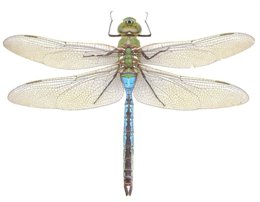 |
| Anax
junius |
 |
|
Common Name:
|
Green Darner, Common Green Darner |
|
Odonata |
|
Order:
|
Odonata |
|
Suborder:
|
Anisoptera |
|
Family:
|
Aeshnidae |
|
Genus:
|
Anax |
|
Species:
|
A. junius |
|
|
| The
Name |
| Anax junius (Drury, 1773), The Green
Darner or Common Green Darner, after its resemblance to a darning-needle,
is a species of dragonfly in the family Aeshnidae. Common throughout North
America, it ranges south to Panama and occurs in the Caribbean, Tahiti,
and Asia from Japan to mainland China. It is the official insect for the
state of Washington in the United States.
The Green Darner is one of the largest
dragonflies existent: males grow to 76 mm (3.0 in) in length with a wingspan
of up to 80 mm (3.1 in).
Females oviposit in aquatic vegetation,
eggs laid beneath the water surface. larval are aquatic carnivores, feeding
on insects, tadpoles and small fish. Adult darners catch insects on the
wing, including ant royalty, moths, mosquitoes and flies.
|
| The
Characteristics |
| The Green Darner is one of the largest
dragonflies, with male sizes ranging from 70-76 millimeters in length and
90-104 millimeters in expanse, and female sizes ranging from about 68-80
millimeters in length and 90-106 millimeters in expanse. Both male and
female are characterized by green thoracic region and a reddish-brown coloration
ventrally in the abdominal region, with the female having slightly lighter
coloration. Both male and female members of this species show light blue
abdominal coloration dorsally. larvals are fully aquatic, six-legged, with
large lateral eyes, elongate wingpads, and underslung mouthparts. Maximum
length of larvals 50-55mm.
The Green Darner prefers still or
very slow-moving fresh water, with lots of aquatic vegetation, and can
only flourish where there are no predatory fish.
Adult Darners catch and eat insects
on the wing, including moths and mosquitos. Dragonflies are excellent aerial
hunters, due to its tremendous flying speed (recorded at up to 18 mph)
and incredible eyesight. They use their powerful jaws to tear apart and
chew up their prey. Green Darner larvals are wholly carnivorous, usually
eating aquatic insects, tadpoles, and very small fish.
|
| The
Reproduction and Development |
| Reproduction usually occurs in the
summer months of July and August. Due to the briefness of the adult darner's
life cycle (perhaps only a few weeks), they are mainly concerned with reproduction.
To prepare for copulation, the male loops his abdomen forward to transfer
semen from his true genital opening to a receptacle located in his secondary
genitilia. Now the male is ready to select a mate. Once he has done so,
the male will fly up to the female and, using his genital claspers located
at the tip of his abdomen, he will grab hold of her by the neck to ensure
that she will not escape. The two will form what looks like a circle with
their bodies as the female aligns her genitilia with the secondary genitilia
of the male located at the base of his abdomen. The male will then insert
his secondary sex organ into the female's vagina, packing down or removing
the sperm of any previous mates. Only after this will the male deposit
his own sperm into the female.
After copulation, the male will continue
to hold onto the female's neck, probably for the rest of the day, in order
to prevent any other males from mating with her, removing his sperm, and
replacing it with their own. The male will fly around with the female while
she lays her eggs, often guiding her to the most ideal spot for the eggs.
Once a location has been selected, the female will insert her ovipositor,
a knife-like egg-laying organ, into pieces of rotting wood or in the stems
of growing plants at the edge of a pond. This egg-laying procedure is the
only form of nurturing that the offspring will receive from their mother.
Females always lay copious amounts of eggs in order to ensure that at least
some will hatch and fully mature into adult dragonflies.
Green Darner eggs will hatch within
about three weeks and small spider-like larvals will emerge.
In warm water regions, where food
is plentiful, a larval may develop in as little as one summer, but as more
often is the case, in cold water regions, where food is less plentiful,
a larval may take as long as four years to fully develop into an adult
darner. Some adults migrate south in winter, and return north to lay eggs
the following spring.
|
| The
Distribution |
| The breeding range of Anax junius
extends from the northernmost part of the United States (Alaska) and south
to Panama; also occurs from Hawaii east to Nova Scotia; also occurs in
West Indies and Tahiti. Known to occur in Asia from Kamchatka south to
Japan and mainland China
|
| The
Protection Status |
| This species is fairly common and
abundant throughout its range. The main threat to its persistence is destruction
of the freshwater habitat it requires to breed. |
|
References:
http://en.wikipedia.org/wiki/Green_Darner
http://animaldiversity.ummz.umich.edu/site/accounts/information/Anax_junius.html
|
| The
Species on Stamps |
|
|
|
|
With courteous to Mr. Richard
Lewington for the Dragonfly Illustration
|
|
|
|
Home | Country
List | Species List
|
|